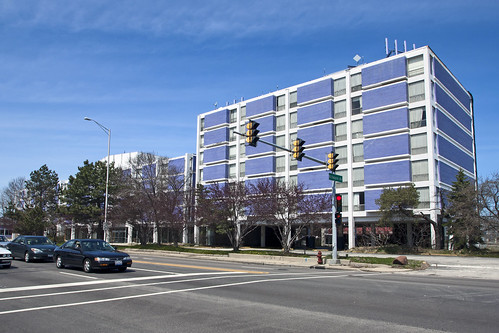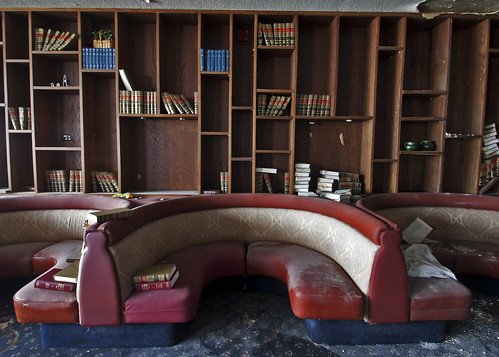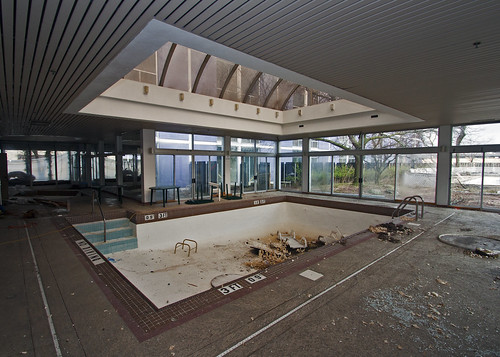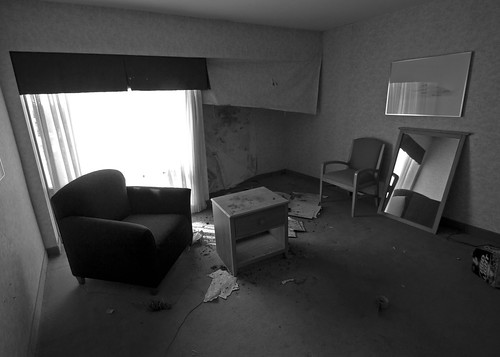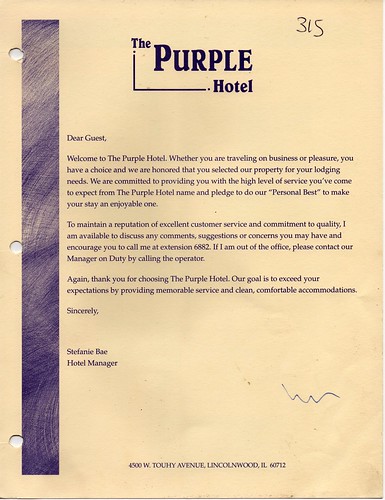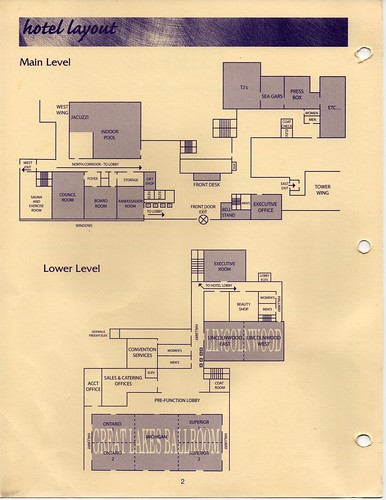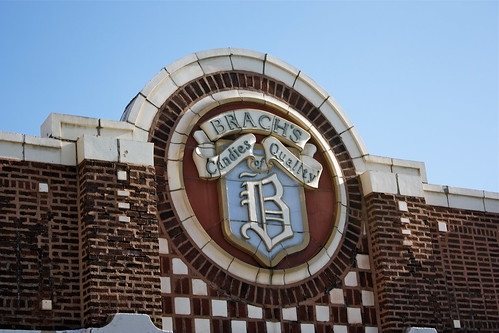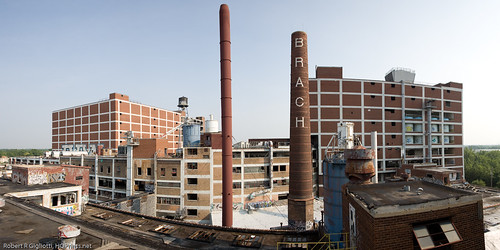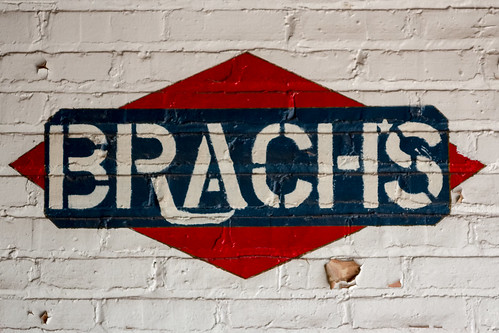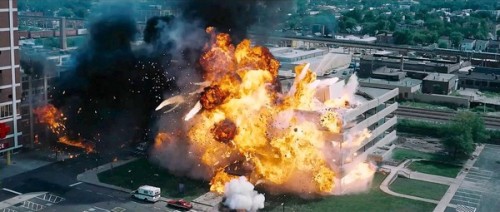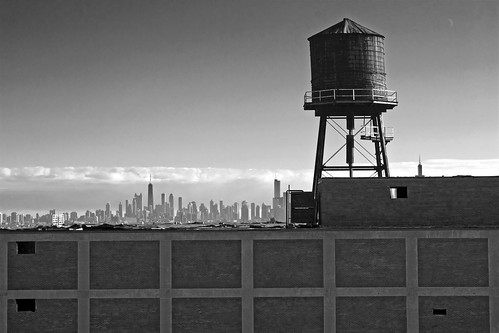Photo: You can’t miss the regal facade of this building driving on Touhy Avenue.
According to one Chicago area native, the construction crew of the 293 room Lincolnwood Hyatt House were supposed to receive a shipment of blue bricks for the building facade. It isn’t clear if a communication or manufacturing error is to blame for the royal purple hue of the bricks, but Hyatt continued construction in spite of the error. Thus, an eccentric Chicago north-side suburb hotspot was born. Although the lodging operated under the Hyatt, Ramada, and Regency banners throughout the years locals colloquially dubbed it “The Purple Hotel.”
Photo: Law books adorn the shelves of TJ’s restaurant connected to the hotel.
In the early the early years the hotel enjoyed a certain level of grandeur. In the 1960’s and 70’s the hotel was a swinging Chicago hotspot. Famous musicians such as Barry Manilow, Roberta Flack, and Perry Como stayed in the hotel when in the Chicago area. The high times came to a screeching halt in 1983 when Teamster Allen Dorfman was murdered in the parking lot. Dorfman had been convicted of conspiring to bribe a US senator and faced up to 55 years in prison. When walking through the parking lot Dorfman was shot eight times with a .22 calibre pistol. FBI wiretaps revealed that the Chicago Mafia may have been connected to the execution style murder. Officials speculate that Dorfman was killed out of fear that he would divulge information from his 30 years of ties with organized crime figures. To date the case is still unsolved and whomever is responsible is still on the loose. The same year the head of Gerber Plumbing, Oscar Gerber, was also murdered at the hotel. A disturbed employee believed he was going to be fired and took Oscar’s life into his own hands.
In 1984 limousine driver George Koehler was standing at O’Hare airport waiting for his fare. After most of the passengers from the flight filed out of the airport Koehler asked the pilots if anyone remained on the plane. The pilots informed Koehler that one more person remained and would be coming shortly. Once the passenger arrived, Koehler ferried the young basketball player who had never been to Chicago before to the purple Lincolnwood Hyatt House. According to ESPN, Koehler and Michael Jordan remain friends to this day.
Photo: Swim at your own risk.
After more than 40 years in operation the hotel was taken over in late 2004 by Village Resorts, Inc., which officially christened the building with its affectionate “The Purple Hotel” moniker. Under new management the hotel boasted of its modernity.
We feature fully renovated and tastefully furnished guest rooms. To ensure that you are completely comfortable, each guest room is spacious and provides a number of amenities to meet the needs of today’s traveler. All rooms have an oversized work desk, two dual-line telephones with data port and voicemail,and state-of-the-art electronic key security system.
Despite efforts to cater to to a certain business clientele, the hotel was synonymous with sleaze. Police were frequently summoned to the hotel for drug and prostitution related offenses. In the May 7, 2008 edition of the Sun-Times the paper notes that the hotel relied on conventions such as the Midwest Fetish Fair & Marketplace for business. The hotel is split into three separate towers and management knowingly tried to segregate known sex parties from the rest of the hotel guests. One news clipping from as far back as 1989 mentions Opposite Sex, Inc. giving several “Meet, Match, Mate” seminars at the hotel.
Village Resorts President Donald Bae positioned Stefanie Bae as hotel manager. In 2005 Stefanie wrote a ringer review for the hotel on the Yahoo! Travel page.
The Purple Hotel had the most friendliest and helpful staff. The food was amazing….and They have a Sunday Brunch that is to DIE for. The rooms were very clean and cozy, excellent value for your money. It is close to everything and they have a sandvolleyball court!!! They have the best steaks in the world!
Grammar and punctuation errors aside, Stefanie may have had a prophetic moment when using the past tense in claiming the “Purple Hotel had the most friendliest and helpful staff.” Acting on complaints by guests, health officials descended upon the hotel in 2006. The inspection led to the discovery of over thirty violations that included a leaking roof, garbage disposal issues, and a failure to exterminate insects and rodents. Of the 293 total guest rooms at the hotel, inspectors sampled 225 for mold. The results did not bode well for Donald Bae as mold was discovered in 208 of these rooms (92.4% of the sample). In September the same year the village of Lincolnwood sued hotel management for failing to fix the myriad of citations. The judge agreed with the village of Lincolnwood and ordered Bae to fix the problems by December. Unable to cover the cost of renovation Bae opted not to fix the issues and in January 2007 a judge ordered the hotel to close. The “most friendliest and helpful staff” suddenly found themselves unemployed.
Photo: The indoor pool is now filled with furniture, glass shards, and dead plants.
Bae attempted to sell the 8.5 acre property in 2008 for the sum of $27 million, but the deal fell through as the real estate market tanked with the economy. In November, 2009 Bae tapped ForeFront Properties LLC to move the site along with two shuttered adjacent commercial properties for $25.8 million. As the property spent months on the real estate market it deteriorated even further. Rather than wait around for Bae on the busy corner of Touhy and North Lincoln Avenue , village officials again took to the courts. If the building is not brought up to code by August 1, 2011 the village has won the right to demolish the purple blemish on their map. The court ruling in Lincolnwood’s favor sticks Bae with the bill for demolition costs. To make matters worse Midwest Bank filed for foreclosure on the property as a $4.2 million loan taken out by Bae has fallen into default. In any case, it looks as though the days for The Purple Hotel are finally numbered.
Photo: One of the hotel rooms with mold growing behind the wallpaper.
Photo: Welcome letter from hotel manager Stefanie Bae.
Photo: Main and lower level maps.
Resources:
ABC – 2007 article that mentions the murder of Oscar Gerber at the hotel.
Chicago Real Estate Daily – 2010 article on Lincolnwood filing a lawsuit agains the Purple Hotel owner.
Chicago Real Estate Daily – 2011 article on the $4.2 million lawsuit filed against the Purple Hotel owner.
Chicago Tribune – 1989 “Meet, Match, Mate” seminars at the hotel.
Chicago Tribune – 2007 article on the closing of the Purple Hotel.
CityNoise – A walk around photo gallery of the abandoned hotel.
Global Traveler Blog – Claims the purple bricks were a mistake.
Google News – 1983 Milwaukee Journal Sentinel article on the Dorfman killing.
Google News – 1983 Pittsburgh Press article on mob ties to Dorfman killing.
Hotel Planner – Has description of hotel services.
Flickr – Martin Gonzalez’ impressive Purple Hotel set.
Flickr – My photo set of The Purple Hotel.
Skokie Patch – Summarizes history of the hotel and redevelopment efforts.
Sun Times – 2011 article that puts an August 1 demolition date on the hotel unless health code violations are fixed.
Yahoo! Travel – Reviews by guests of the Purple Hotel.
Wikipedia – Lincolnwood entry has a bit of Purple Hotel history.
Wikipedia – Allen Dorfman was killed in the parking lot. The crime remains unsolved.
